Inequalities
Section 0.3 of the textbook focuses on inequalities.
Inequalities as Comparing Order
In algebra, we are often interested in comparing two different
expressions to determine the relative order of the expressions.
That is, if \(A\) and \(B\) are two expressions that have numerical values,
then we write \(A > B\) to say \(A\) is greater than \(B\), and \(A < B\) to say
that \(A\) is less than \(B\).
Like an equation, an inequality is a logical statement that is either
true or false. When the expressions involve variables, the inequality can
be always true, sometimes true, or never true.
To solve an inequality, we try to find that set of values for the independent variable
for which the inequality is true.
If we graph the two expressions being compared, the independent variable
corresponds to the horizontal axis, and the values of the expressions correspond to
the vertical axis. To say that \(A > B\) means that the points on the graph for \(A\)
are above the points on the graph for \(B\).
To say that \(A < B\) means that the graph of \(A\) is below the graph of \(B\).
Example: Interpret the inequalities \(x^2 < x+2\) and \(x^2 > x+2\)
by using the graphs \(y=x^2\) and \(y=x+2\).
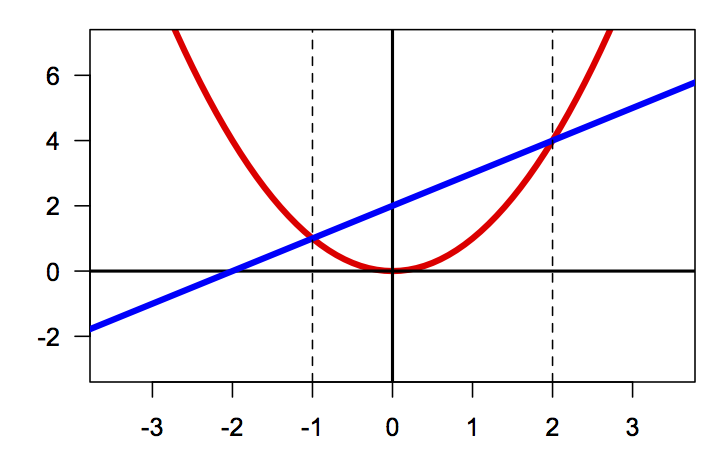
The graph shows \(y=x^2\) in red and \(y=x+2\) in blue. Two vertical dashed lines
are also shown where the two graphs cross, that is at the solutions to \(x^2=x+2\).
For \(x<-1\), we see that the red graph is above the blue graph,
\(x^2 > x+2\). For \(x>-1\) and \(x<2\), the red graph is lower, \(x^2 < x+2\).
For \(x>2\), we have \(x^2 > x+2\) since the red graph is once again above the
blue graph.
Solution sets to inequalities are usually expressed using interval notation.
This is discussed in Section 0.1 of the textbook. The inequality \(x^2 < x+2\)
is true when \(x>-1\) and \(x<2\), which is written in set notation as
\[ \{x: x^2 < x+2\} = \{x : -1 < x < 2\} = (-1,2). \]
The inequality \(x^2 > x+2\) has a solution set the involves two disjoint intervals,
\(x<-1\) as well as \(x>2\). Logically, a particular value \(x\) can only satisfy
one of the inequalities, so we say \(x<-1\) or \(x>2\). In set notation,
the solution set is written
\[ \{x : x^2 > x+2\} = \{x : x < -1 \hbox{ or } x>2\} = (-\infty,-1) \cup (2,\infty). \]
Mathematically, inequalities are most appropriately considered using the difference
between two expressions. Suppose \(A\) and \(B\) are two expressions. We say
\(A > B\) if the difference \(A-B\) is a positive value. The difference (subtraction)
\(A-B\) measures the value needed to add to \(B\) to reach \(A\). I like to think
of this as imagining I start at the value of \(B\) and ask how much I need to change to
reach \(A\). So when \(A-B\) is positive, I need to change by a positive amount to go
from \(B\) to \(A\) so that \(A > B\). On the other hand, when \(A-B\) is negative,
this means that I need to change by a negative amount to go from \(B\) to \(A\) so that
\(A < B\).
Every inequality can be transformed using subtraction into a new inequality that
makes a comparison with 0, which turns the inequality from a question about relative
order between two expressions into a question about whether a single expression
is positive or negative. This becomes particularly important since we often need
to use factoring as a strategy for solving inequalities. Factoring is not helpful
for comparing two different expressions, but it is useful in determining where
a single expression is positive or negative.
Example: Interpret the inequalities \(x^2 < x+2\) and \(x^2 > x+2\)
by using the graph of \(y=x^2 - (x+2)\).
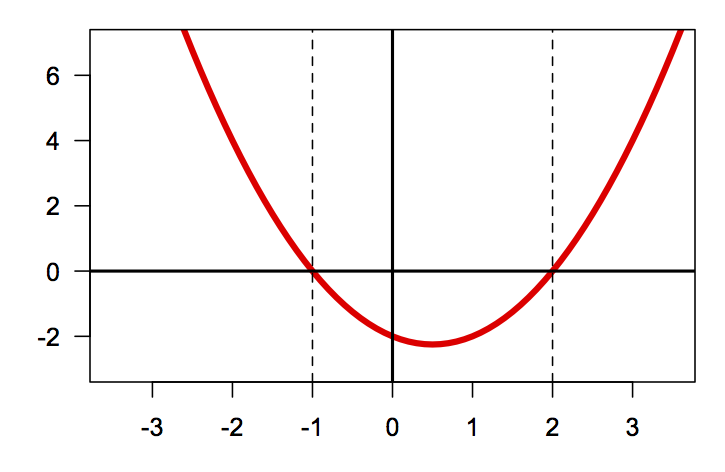
This inequality is the same as for the previous example. If we view the difference
\(x^2-(x+2)\) as \(A-B\), then we view the graph as how much we need to change
to go from \(y=x+2\) to reach \(y=x^2\). In fact, you should compare the graph
of the difference shown here with the graphs of the two expressions in the previous
example. Can you see how the graph \(y=x^2\) is above \(y=x+2\) whenever the
graph of the difference is positive (above the axis)?
The difference is positive for the values \(x\) with \(x<-1\) and for the
values \(x\) with \(x>2\). This allows us to interpret the solution set
\[ \{x : x^2 > x+2\} = \{x : x < -1 \hbox{ or } x>2\} = (-\infty,-1) \cup (2,\infty). \]
On the other hand, the difference is negative for the values \(x\) with
\(x>-1\) and \(x<2\), giving us the solution set
\[ \{x: x^2 < x+2\} = \{x : -1 < x < 2\} = (-1,2). \]
Because the comparison for the difference is with zero, we can identify the two
points where the difference equals zero using factoring.
The difference is \(x^2-x-2\) which can be factored \(x^2-x-2=(x-2)(x+1)\).
Solving the equation \(x^2-x-2=0\) is then transformed into finding those
values \(x\) for which \(x-2=0\) or \(x+1=0\), which gives the two solutions
\(x=2\) and \(x=-1\).
Inequalities as Comparing Distance
In calculus, we will be considering approximations to quantities.
For example, we might have a relation between two variables and we want to
know how close a linear model approximates the true relation. Or we might
have an experiment where we need to measure one of the control variables
to obtain some output. But a little error in the control will lead to an
error in the output. We should then consider how much of an error in
the control will allow us to maintain a certain accuracy in the output.
Distance is measured using absolute values. Recall that the difference
\(A-B\) measures how much we need to change to go from \(B\) to \(A\).
Then \(B-A\) measures how much we need to change to go from \(A\) to \(B\).
These two differences have the same distance, but are in opposite directions.
So the distance between two values \(A\) and \(B\) is given by the absolute
value of the difference:
\[ \mathrm{dist}(A,B) = |A-B| = |B-A|.\]
This definition is stated as Definition 0.8 in Section 0.1 of the textbook.
Absolute value measures the magnitude or size of a number without
regard to if the number is positive or negative. The magnitude of a number
is its distance from zero. Additive inverses are always the same distance
from zero but on opposite sides on the number line. So the magnitude of
a positive number is the itself. But the magnitude of a negative number
is equal to its additive inverse, which will be positive.
This is the motivation for the piecewise definition of absolute value:
\[
|x| = \begin{cases}
x, & \hbox{if } x \ge 0, \\
-x, & \hbox{if } x < 0
\end{cases}
\]
The \(-x\) in this definition does not mean a negative number but is
the way to talk about the additive inverse of \(x\), which is what
is used when \(x<0\).
The two common questions about distance that lead to inequalities are
about two quantities \(A\) and \(B\) being close to some degree or being
far apart to some degree. Let \(\delta\) represent an acceptable threshold
distance. To say that \(A\) and \(B\) are closer together than the
distance \(\delta\) gives the inequality
\[|A-B| < \delta.\]
To say that \(A\) and \(B\) are further apart than the distance \(\delta\)
gives the inequality
\[|A-B| > \delta.\]
Theorems 0.22 and 0.23 in Section 0.3 are motivated by these ideas.
Example: Express \(\{x : |x-3|<2\}\) using interval notation.
The inequality \(|x-3|<2\) is an absolute value inequality, so it can
be interpreted in terms of distance. There are multiple perspectives to the
inequality, all of which give the same result.
The most direct approach is to do pattern matching with \(|A-B| < \delta\)
and recognize that the inequality \(|x-3|<2\) has the distance interpretation
that the distance between \(x\) and \(3\) is less than 2
(alternatively read as at most 2
). Since 3 is a definite number, we can
mark it on the number line and travel a distance 2 in both directions to reach
the numbers 1 and 5.

The numbers whose distance from 3 is less than 2 are those
that are between 1 and 5.
\[ \{x : |x-3| < 2\} = \{x : 1 < x < 5\} = (1,5). \]
A second approach is to think of \(x-3\) as an expression that we can graph.
The inequality \(|x-3| < 2\) can also be interpreted as saying that this
expression is at most 2 units away from 0, which is the horizontal axis.
So a graphical interpretation of this inequality would show the graph
\(y=x-3\) along with horizontal lines at \(y=-2\) and \(y=2\) which represent
the limit of the allowed distance. We want to find the values of the
independent variable \(x\) so that the graph \(y=x-3\) appears between
the two threshold lines.
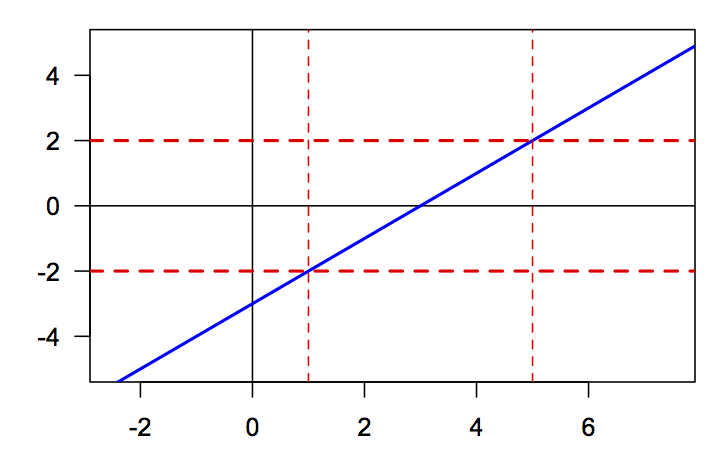
We see that the graph \(y=x-3\) is between the two thresholds when
\(x\) is between 1 and 5.
\[ \{x : |x-3| < 2\} = \{x : 1 < x < 5\} = (1,5). \]
A third approach is to view \(|x-3|\) as the distance between the expressions
\(x\) and \(3\). This is similar to the first approach, except that instead of
thinking about \(x\) and \(3\) as numbers on a number line, we will graph
both expressions \(y=x\) and \(y=3\). We seek to find values \(x\) so that
the distance between these graphs is less than 2. We do this by also graphing
threshold curves that show when we are within the desired distance.
For example, we could consider \(y=3\) as the reference value so
that the threshold curves are found by adding and subtracting 2 to
get \(y=5\) and \(y=1\). We are now interested in when the other
expression \(y=x\) is found between the threshold curves.

We see that the graph \(y=x\) is between the two thresholds \(y=1\)
and \(y=5\), meaning less than a distance 2 from \(y=3\), when
\(x\) is between 1 and 5.
\[ \{x : |x-3| < 2\} = \{x : 1 < x < 5\} = (1,5). \]
However, we could also consider \(y=x\) as the reference value
and the threshold curves are found by adding and subtracting to 2 get
\(y=x+2\) and \(y=x-2\) as the thresholds. We then seek to find where
the other expression \(y=3\) is found between these thresholds.
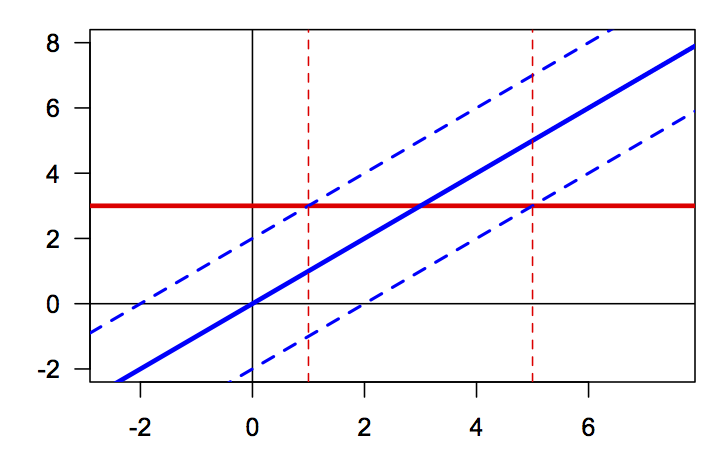
Of course, it is no surprise that we find the same solution set,
\[ \{x : |x-3| < 2\} = \{x : 1 < x < 5\} = (1,5). \]
Example: Use a graph to determine the solution set
\(\{x : |x^2+5x|>1\}\) using interval notation.
We can consider this problem in three different ways, each of which will
give the same result. The first is to consider a single expression
\(y=x^2+5x\) and determine when this graph is outside the band of
thresholds that are found 1 unit away from the horizontal axis, \(y=0\). Graphically,
we see when \(y=x^2+5x\) is outside both \(y=-1\) and \(y=1\).

The other
approaches require that we consider \(x^2+5x\) as a difference,
which requires introducing an additive inverse, \(x^2+5x = x^2 - -5x\).
Then we consider the graphs \(y=x^2\) and \(y=-5x\), and we want to
know when the distance between these values is more than 1 unit.
One approach is to see when \(y=-5x\) is outside the band formed by \(y=x^2-1\) and \(y=x^2+1\).
Or we can see when \(y=x^2\) is outside the band formed by \(y=-5x-1\) and \(y=-5x+1\).

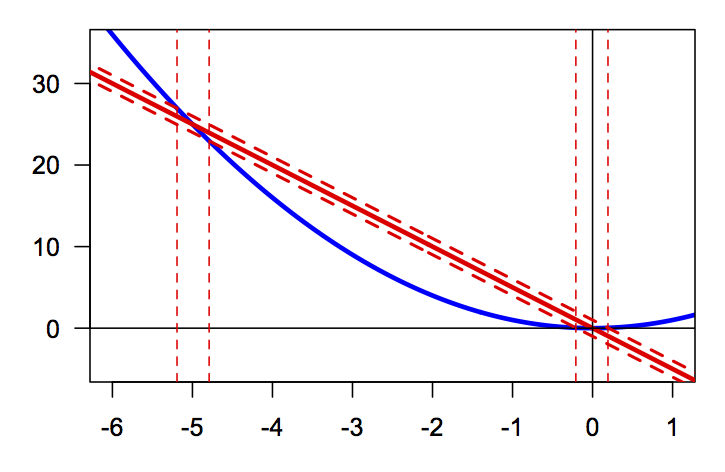
Although the pictures of these different threshold bands look somewhat
different, the locations where the various curves cross the thresholds are
always the same. These points are found as the solutions to the equations
\[x^2+5x=-1 \qquad \hbox{or} \qquad x^2+5x=1.\]
To solve these equations, we need to move everything to one side
so the equation is an expression equals zero,
\[x^2+5x+1=0 \qquad \hbox{or} \qquad x^2+5x-1=0.\]
Both of these are quadratic equations, which are solved using
the quadratic formula to find the four points,
\[x=\frac{-5\pm\sqrt{21}}{2} \qquad \hbox{or} \qquad x=\frac{-5\pm\sqrt{29}}{2}.\]
Ordering these values left to right, we can identify how the
values relate to the graph,
\[ \frac{-5-\sqrt{29}}{2} < \frac{-5-\sqrt{21}}{2}
< \frac{-5+\sqrt{21}}{2} < \frac{-5+\sqrt{29}}{2}.\]
The solution to the inequality involves three disjoint intervals,
so that the solution set is the union
\[ (-\infty,\frac{-5-\sqrt{29}}{2}) \cup
(\frac{-5-\sqrt{21}}{2},\frac{-5+\sqrt{21}}{2}) \cup
(\frac{-5+\sqrt{29}}{2},\infty).\]
In practice, it is mathematically easiest to work with the interpretation
of the inequality as a single expression's distance from zero. So although
a problem may originally be constructed in terms of two expressions being
within some distance of each other, we want to think of the difference as
a single expressions so that the problem is written as \(|A|<\delta\) or
\(|A|>\delta\).
A problem of the form \(|A|<\delta\) states that the value of \(A\) is a
a distance less than \(\delta\) from zero, which means that \(A\)
should be inside the thresholds at \(\pm \delta\). So we solve
the inequality
\[ -\delta < A < \delta. \]
A problem of the form \(|A|>\delta\) states that the value of \(A\) is
a distance greater than \(\delta\) from zero, which means that \(A\)
should be outside the thresholds at \(\pm \delta\). So we solve
two different inequalities and form the union of the solution sets,
\[ A < -\delta \qquad \hbox{or} \qquad A > \delta. \]
Algebraic Strategies
On this page, we have focused on understanding how to interpret and setup
appropriate inequalities. Inequalities are solved using techniques that
are quite similar to those used for equations, with some very important differences.
- Isolation as a method for solving inequalities.
- Factoring (and sign analysis) as a method of
solving inequalities.
Go back to the Table of Contents.








